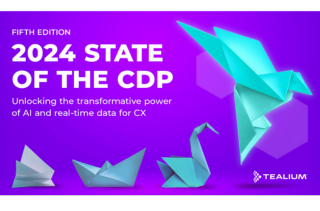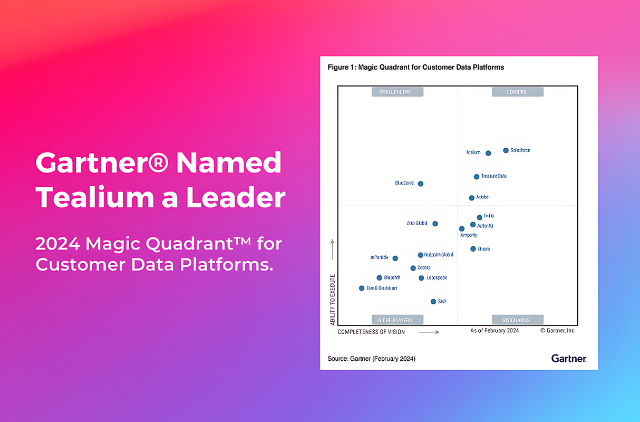Tealium is named a Leader in what we believe is a milestone moment for the CDP category
This is part 1 of a 2-part blog series on the Gartner® Magic Quadrant™ for Customer Data Platforms. Part 1 (below) looks at the history of the category up until this point and Part 2 is a deep dive into the finding of the Magic Quadrant report itself.
A wise man once told me the CDP category needs no validation, the market has already done that. I couldn’t agree more.
Alas, it’s still good to be recognized! (And, as a vendor, who are we kidding? We’ll take all the attention thrown our way!)
The Gartner® Magic Quadrant™ for Customer Data Platforms is meaningful for us! Gartner is a $5.5 billion company, a member of the S&P 500, works with businesses in nearly 90 countries, has over 19,500 associates in 85 offices globally, and has over 40 years of providing insights and expert guidance to clients’ enterprises worldwide. A Gartner Magic Quadrant is a culmination of research in a specific market, giving you a wide-angle view of the relative positions of the market’s competitors.
If you’re in the market for a CDP or own a CDP and want to better understand the landscape, it’s a must-read. If you’re not a Gartner client, never fear! To read the full report, grab a complimentary copy here
With such a milestone for the category, it’s useful to look back and see how we got here. Both as a way of understanding what makes the CDP category unique and valuable to the industry and to think about what’s next and where the CDP fits in for those riding the latest technological wave.
The Early Days
The CDP industry is lucky to have had early and passionate advocates like David Raab, Founder of the CDP Institute. Reaching this moment for the category is in no small part due to his efforts. Heck, he’s credited with coining the term “Customer Data Platform” in the first place back in April 2013, and he continues to tell the CDP story to those who are just joining the crowd today (highly recommended to check out the CDP Institute).
Back then he said, “It has taken me a while to connect the dots, but I’m now pretty sure I see a new type of software emerging. These systems gather customer data from multiple sources, combine information related to the same individuals, perform predictive analytics on the resulting database, and use the results to guide marketing treatments across multiple channels.” There are a few things we’d quibble with from this early coverage, but this is remarkable foresight that has only proven more true over time.
Not coincidentally, this was the same year Tealium released a product called AudienceStream, featuring many of the capabilities that became the hallmark of the CDP category. It’s crazy to think that was over a decade ago!
Just a few years later in 2016, the CDP Institute was founded and clear patterns emerged as to the types of CDPs that were coming to market. This is also when CDPs first appeared in the Gartner Hype Cycle™ for Digital Marketing and Advertising, 2016. Tealium was recognized as a Sample Vendor in the report. Tealium has been working to orchestrate data between systems with a heavy focus on data quality ever since.
Entering the space, you had a variety of companies. You had data-centric vendors like Tealium working to be a neutral data layer for the enterprise. You had campaign management tools that ran campaigns and centralized data across multiple channels with a heavy focus on marketing channel execution. You had systems that were similar to mini data warehouses with analytics built on top and a heavy focus on data visualization. To this day, the heritage of the various systems as they entered the CDP market persists in the way they approach managing data for the benefit of customer experience.
But it wasn’t all sunshine and rainbows for the category back then. The category has been under assault from all sides for its entire existence. Whether it’s unrelated vendors trying to position around a hot term, or proponents of old technology taking potshots at the new kid on the block, or even some industry analysts questioning the value of “mere pipes” between technologies, the CDP category has had a baptism by fire and come out stronger on the other side.
The head of product for one vendor who did very well in the report (and who shall remain nameless) even said this about CDPs on June 18th, 2018, “I think it’s a passing fad.” Ouch. Think about that! 5 years into the category’s existence, and just over 5 years ago from where we sit today, this is what the SaaS vendor was saying. Fast forward to today and now a proud and leading participant in the market.
But the promise of the category, and the expertise of the vendors within it, would not be denied. I think that speaks to the strategic value of the category’s promise: using customer data as the differentiator for your business.
It didn’t come without learning along the way. We, for example, called our platform, with our newly fangled CDP capabilities, the “Universal Data Hub”. Maybe a tad ambitious, but you get what we were going for. There’s an argument to be made that maybe we should go back to that at this point in our product’s evolution. Today, you commonly see commentary about CDPs “going beyond” marketing into customer service, sales, and other use cases.
I mention it, because way back then you could very distinctly see the seeds of a vision planted. Seeds that have matured today and blossomed into a category that’s proven its worth.
Coming of Age
When the category started gaining traction, skepticism remained. Analysts had a common refrain that at some point the category would have to do more than just cart abandonment campaigns. And vendors would have to become more than “just pipes”.
Of course, I think it’s safe to say that any vendor whose vision stopped at cart abandonment campaigns and/or who merely viewed themselves as a collection of integrations did not last long. Then again, the “dumb pipes” category seems to be just now re-emerging on the market, albeit with a different name than CDP.
If you want a funny juxtaposition of the product vision of the various vendors competing in the data space as the CDP category emerged, compare that article above about CDPs being a passing fad with this interview with Tealium’s CEO, Jeff Lunsford, 2 months after the one above.
In the interview, Jeff said, “We believe there are 5 mandates for successful digital transformation”:
- Put the customer at the center of your business. Technologically and operationally.
- Do this in real-time. If you ingest data in a manual, batch way it could take 24 hours to get the data in and you’re now trying to create a personalized experience based on what someone was interested in yesterday. That doesn’t work in the long term.
- Follow the privacy laws. With all this data comes great responsibility (i.e. GDPR in Europe and privacy regulations in California).
- Machine Learning (ML) ready. A human cannot process this data alone because of the sheer volume of data today. It needs to be programmatically managed and able to leverage sophisticated ML algorithms.
- Data should flow freely across the enterprise. It needs to be accessible and real-time for all teams that are accessing it (i.e. when a customer calls into a call center that department can see any actions that same customer just took on the website), while still following privacy laws.
I can personally confirm the vision that Jeff shared then in 2018 is remarkably similar to the founding principles of Tealium in 2011, and virtually a carbon copy of what we still use today. Ultimately, it’s staying true to this type of vision that led CDPs to the promised land despite all the noise and the perception of volatility. Customer-centric, real-time, build trust with privacy, be ready for AI/ML, and enterprise-wide are the tenants upon which Tealium believes this is just one small milestone for the customer data movement.
CDPs Make It to The Big Show
Is it a coincidence that we sit here on the precipice of an AI revolution and that’s when CDPs finally get a Magic Quadrant? Precisely at the time when the value of data is about to get its hockey stick moment? I think not. And that’s to say nothing of the value being scaled by going “beyond marketing” with your CDP that’s quite a popular trend today.
It’s this scale of value that has brought us to this point today where I think it’s safe to say that CDPs have gone mainstream.
Do we need an MQ to tell us CDPs are important? Absolutely not.
According to our 2024 State of the CDP (which is a massive, market-wide, global survey of 1,200 professionals), the results speak for themselves:
- 90% of companies with CDPs are very satisfied with their investment
- Companies with a CDP showed high levels of satisfaction in meeting their business goals over the past 12 months (89%), significantly higher than those without a CDP (60%)
- 48% of CDP adopters reported observing ROI within six months, a significant majority (79%) achieved ROI within the first 12 months, and an even higher proportion (91%) reached this milestone within 18 months
However, even though they say we live in the “post-truth” era, we still think expert opinions matter. And we couldn’t be happier for the CDP category, and customer data management overall, to have Gartner covering the space with it’s preeminent Magic Quadrant report.
So as we sit here today proud to see such a prestigious inaugural report for the category, we look forward to further growth for CDPs expanding the scope of data under management, increasing the intelligence represented within this data, reducing the amount of time it takes to manage, all while better connecting the ecosystem for the benefit of customers.
If you’re interested in reading the Gartner Magic Quadrant for Customer Data Platforms, you can download your copy here.
As you ponder the CDP category, be sure to check out our latest product vision for 2024 so you can see what exciting capabilities are in store for the future.
Gartner, Magic Quadrant for Customer Data, Lizzy Foo Kune, Rachel Smith, Benjamin Bloom, Suzanne White, Adriel Tel, David Walters, February 14, 2024. GARTNER is a registered trademark and service mark of Gartner, Inc. and/or its affiliates in the U.S. and internationally, and HYPE CYCLE and MAGIC QUADRANT are registered trademarks of Gartner, Inc. and/or its affiliates and are used herein with permission. All rights reserved. Gartner does not endorse any vendor, product or service depicted in its research publications, and does not advise technology users to select only those vendors with the highest ratings or other designation. Gartner research publications consist of the opinions of Gartner’s research organization and should not be construed as statements of fact. Gartner disclaims all warranties, expressed or implied, with respect to this research, including any warranties of merchantability or fitness for a particular purpose.
![state of cdp smaller]() Get the report
Get the report
 Get the report
Get the report
![AWS_Tealium_NAV Tealium + AWS logos]() Learn more
Learn more
 Learn more
Learn more

